Vestil TM-20-DC Handleiding
Vestil
Niet gecategoriseerd
TM-20-DC
Bekijk gratis de handleiding van Vestil TM-20-DC (19 pagina’s), behorend tot de categorie Niet gecategoriseerd. Deze gids werd als nuttig beoordeeld door 38 mensen en kreeg gemiddeld 5.0 sterren uit 19.5 reviews. Heb je een vraag over Vestil TM-20-DC of wil je andere gebruikers van dit product iets vragen? Stel een vraag
Pagina 1/19

1
VESTIL MANUFACTURING CORPORATION
P.O. Box 507., Angola, IN 46703 USA
Phone (260) 665-7586 • Fax (260) 665-1339
E-mail: sales@vestil.com • www.vestil.com
TILT MASTER & TILT MASTER STRADDLE
MODELS TM / TMS
OWNER'S
MANUAL
Revised 0821
15-126-121
A company dedicated to solving ergonomic and material
handling problems since 1955
.
Ergonomic Solutions
Contents
Warnings & Safety Instructions ....................... 1
Replacement Parts .......................................... 1
Receiving Instructions ..................................... 1
Operation Instructions .................................. 2-3
Routine Maintenance & Safety Checks ........... 4
TM Exploded Structural Parts ......................... 5
TM, TMS Bill of Materials ................................ 6
TMS Exploded Structural Parts ........................... 7
Electrical Diagrams .......................................... 8
Motor & Transformer Diagrams ........................ 9
Hydraulic Diagrams ........................................ 10
Power Unit’s Operation .................................. 11
Modular Power Unit Breakdown - DC ....... 12-13
Modular Power Unit Breakdown - AC........14-15
Troubleshooting ............................................. 16
Safety Label Identification .........................17-18
Warranty ......................................................... 19
WHEN ORDERING REPLACEMENT PARTS
We take pride in using quality parts on the equipment we
manufacture. We are not responsible for equipment problems
resulting from the use of unapproved replacement parts.
To order replacement or spare parts for this equipment,
contact the factory.
In any communication with the factory please be prepared to
provide the machine’s serial number, which is indicated on the
machine dataplate.
RECEIVING INSTRUCTIONS
Every unit is thoroughly tested and inspected prior to
shipment. However, it is possible that the unit could incur
damage during transit.
Inspect the unit closely when it arrives.
If you see evidence
of damage or rough handling to either the packaging or to the
product when it is being unloaded, immediately make a note of
it on the Bill Of Lading!
It is important that you remove the product’s packaging upon
its arrival to ensure that there is no concealed damage or to
enable a timely claim with the carrier for freight damage.
Also verify that the product and its specifications are as
ordered.
E
N
G
L
I
S
H
F
R
A
N
Ç
A
I
S
E
S
P
A
N
O
L
WARNINGS & SAFETY INSTRUCTIONS
Ensure that all employees understand and follow the
following.
• Read and understand the owner’s manual before using or
servicing the Tilt Master.
• For battery powered units, review the additional warnings
included in the “Operation Instructions” section of the
manual.
• Watch the container carefully when the tilter is in opera-
tion.
• Have the caster lock engaged solidly when the tilter is in
operation.
• Verify the container (not just the pallet) is fully back
against the fork carriage before tilting.
• Be alert of the possibility of parts falling from the container
when it is being tilted.
• Before transporting the container, raise the forks slightly.
• The load must be removed and the forks fully lowered
before any work is performed on the hydraulic system.
• Do not use the Tilt Master if damage or unusual noise is
observed.
• Do not perform any modifications to the Tilt Master without
the manufacturer’s approval. Failure to receive authoriza-
tion for changes to the equipment could void the warranty.
• Maintenance and repairs are to be done only by personnel
qualified to perform the required work.
• Do not use brake fluid or jack oils in the hydraulic system.
If oil is needed, use an anti-wear hydraulic oil with a
viscosity grade of 150 SUS at 100° F, (ISO 32 cSt @ 40° ),
or Dexron transmission fluid.
• Ensure that safety and warning labels stay in place and
are legible.
• Use only replacement parts either supplied or
approved by the manufacturer.
TMS-SERIES Tilt Master
STRADDLE
TM-SERIES Tilt Master
NOTE: Pages 12-15 are views of the modular power unit.
These diagrams only apply to units manufactured before
12-01-2018. Units manufactured after 12-01-2018
receive a redesigned modular power unit (MPU GEN2).
Diagrams and operating instructions for GEN2 power units
are provided in separate MPU-AC/DC manuals.

2
OPERATION INSTRUCTIONS – TM, TMS
•
Ensure that all employees involved in the operation of the Tilt Master model box/basket rotator understand and follow
these instructions!
The standard model Tilt Master is suitable for use indoors in most industrial locations. It is intended to be used to
transport, lift and rotate rigid, sturdy tote boxes or baskets containing nonhazardous materials so that they can be
gradually, manually unloaded. The model TM is intended for use only with open-bottom pallets or skids. The model TMS
can be used with either open- or closed-bottom pallets.
Loading:
The load rating, in pounds, is shown on the machine dataplate located on the top of the fork carriage. It indicates the
net capacity of the tilter, based on loads having a center of gravity not exceeding 20” horizontally and 20” vertically. The
load must be evenly distributed across both of the lifting forks.
Warning:
Do not exceed the load ratings stated above. Injury to personnel or permanent damage to the machine could
result from exceeding the listed capacity.
Warning:
Tilting any load exceeding the 20” center of gravity rating (either horizontally or vertically) can potentially cause
the Tilt Master to become unstable and tip over.
Caution:
Do not drop loads onto the Tilt Master’s forks. Shock loads to the carriage can cause premature wear and
damage to the structure and its parts.
Note:
The addition of any ancillary equipment to the Tilt Master by third parties must be taken into account when deter-
mining the maximum centers of gravity and working load that can be placed on the fork carriage.
To load the Tilt Master, fully lower the fork carriage. Push the tilter’s forks under the skid or container, or place the skid
or container on the forks with a fork truck, until the skid or container is back against the carriage. The forks can be raised
slightly to lift them off of the load rollers, and the load can be moved to the work location.
Operation:
When the Tilt Master is in the desired location, depress the pedal on the side of each swivel caster to prevent the tilter
from rolling during its operation.
Warning:
Do not tilt loads more than two inches off the floor without the caster brakes properly engaged, to prevent the
unit from rolling.
Warning:
Keep personnel clear of the machine when it is in operation.
Warning:
Loads in containers can shift quickly when tilted. Always have an effective escape route for personnel to be
able to avoid being trapped or injured in the event there is an unexpected movement of the material or the machine.
Caution:
Always carefully watch the Tilt Master and any load on it when it is in operation.
Warning:
Be certain no part of any person or object is under the forks or fork carriage before lowering the unit.
The Tilt Master is furnished with a constant-pressure (dead-man style) push-button control.
Press the “UP” push-button to turn on the power unit to rotate the forks upward. The forks will rotate only while the
control is pressed. Upon releasing the control, the forks will stop and hold position.
Pressing the “DOWN” push-button energizes the lowering valve to allow the forks to rotate downward by gravity (the
motor does not run). Again, releasing the control will stop the forks’ movement, and the unit will hold its position.
Caution:
Never use the tilter if any damage or unusual noise is observed, if it is in need of repairs, or if it seems to be
malfunctioning. Notify your supervisor or maintenance personnel if you notice anything out of the ordinary.
On DC-powered units, attempting to raise the carriage when the battery is low will cause the motor relay protection to
prevent the motor’s operation. Adequate battery voltage is indicated by a green LED on the motor relay. See the next
page for more notes regarding operation of battery-powered units.
Ensure that all safety and warning labels stay in place and are legible. Refer to the labels page in this manual.

3
ADDITIONAL INSTRUCTIONS FOR BATTERY-POWERED UNITS
Note: If this product has the 24V powered traction-drive option, consult that option’s information for more
specific details regarding the batteries and battery charger.
Warning!
! Working with or near lead acid batteries is dangerous. Batteries contain sulfuric acid and produce explosive gases.
A battery explosion could result in loss of eyesight or serious burns.
! Do not smoke or allow a spark or flame near batteries. Charge batteries in locations that are clean, dry, and well
ventilated. Do not lay tools or anything metallic on top of any battery. All repairs to a battery must be made by
experienced and qualified personnel.
! When working with batteries, remove personal items such as rings, bracelets, necklaces, and watches. Batteries can
produce enough energy to weld jewelry to metal, causing a severe burn.
! Always have fresh water and soap nearby in case battery acid contacts skin, clothing, or eyes.
! Operating the battery with a low battery voltage can cause premature motor contact failure.
! Do not expose the tilter or charger to rain or adverse conditions.
! Replace defective cords or wires immediately.
! Check the battery’s water level frequently.
Battery Charger Operating Instructions
Never operate the charger with either of the cables coiled. Operating a battery charger with the cord either coiled or
wrapped around itself could cause the cord to overheat, melt, and cause a short-circuit or a fire.
Connection: the ribbed wire of the charger’s output cord must be connected to the battery’s negative (-) terminal. The
non-ribbed wire (with words printed on it) must be connected to the battery’s positive (+) terminal.
When properly connected, the charger will indicate the status of its output:
Flashing green LED – the charger is not seeing a good connection to the battery.
Solid yellow LED – the charger is providing charging current to the battery.
Solid green LED – the charger is maintaining a fully charged battery.
Plug the charger into a standard 115V receptacle. If an extension cord must be used, keep it as short as possible.
Caution:
Remember to unplug the charger before moving the equipment. Failure to do so could cause damage to
cords, receptacles, and other equipment.
The battery charger can be left connected to the battery indefinitely without risk of harming the battery.
Troubleshooting
If the unit does not operate, check all of the wiring connections to make sure they’re both mechanically and electri-
cally sound – specifically at the battery, the motor, and at any location a wire is connected to the chassis. Also, make
sure the quick-connect plug on the end of the pendant control cord is plugged in correctly (if applicable).
A fully charged lead acid battery in good condition at room temperature should read 12.65 volts. At 11.9 volts it is
considered to be fully discharged and in need of charging. When checking battery voltage, wait at least 1/2 hour
after the charger has been turned off before checking the battery’s voltage.
If the batteries don’t seem to be taking a charge, check the charger’s 115V supply circuit and the charger’s output with a
voltmeter. If all check okay, confirm the battery’s state of charge using a hydrometer or a voltmeter.
E
N
G
L
I
S
H
Product specificaties
| Merk: | Vestil |
| Categorie: | Niet gecategoriseerd |
| Model: | TM-20-DC |
Heb je hulp nodig?
Als je hulp nodig hebt met Vestil TM-20-DC stel dan hieronder een vraag en andere gebruikers zullen je antwoorden
Handleiding Niet gecategoriseerd Vestil
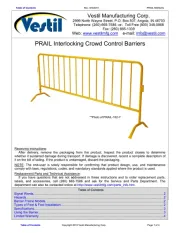
27 Augustus 2025

27 Augustus 2025
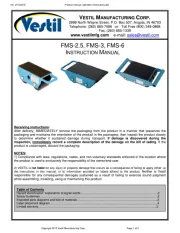
27 Augustus 2025
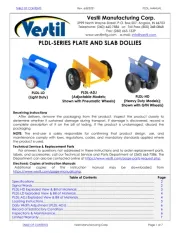
27 Augustus 2025
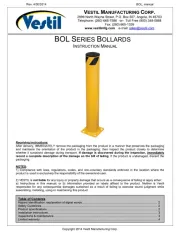
26 Augustus 2025
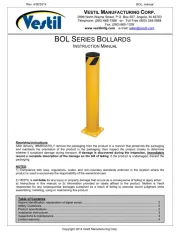
26 Augustus 2025
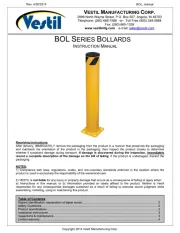
26 Augustus 2025
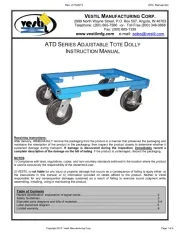
26 Augustus 2025
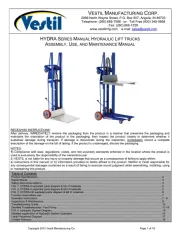
26 Augustus 2025
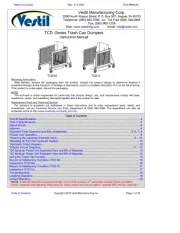
26 Augustus 2025
Handleiding Niet gecategoriseerd
- Tineco
- Musser
- Spanninga
- Ruger
- Weil
- MOZA
- City Theatrical
- A3
- Leitner
- Focal
- Urbanista
- Danby
- Baja Mobility
- Doughty
- Newland
Nieuwste handleidingen voor Niet gecategoriseerd
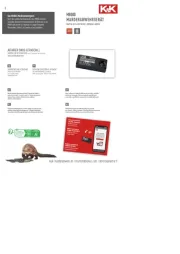
13 September 2025
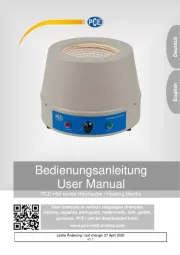
13 September 2025

13 September 2025
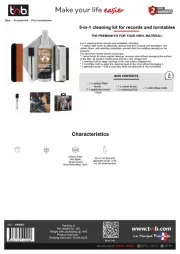
13 September 2025
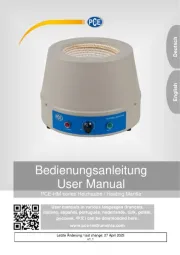
13 September 2025

13 September 2025
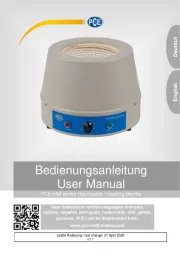
13 September 2025
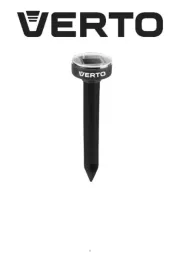
13 September 2025
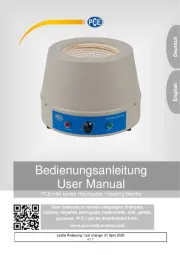
13 September 2025
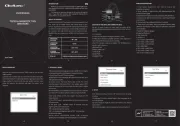
13 September 2025